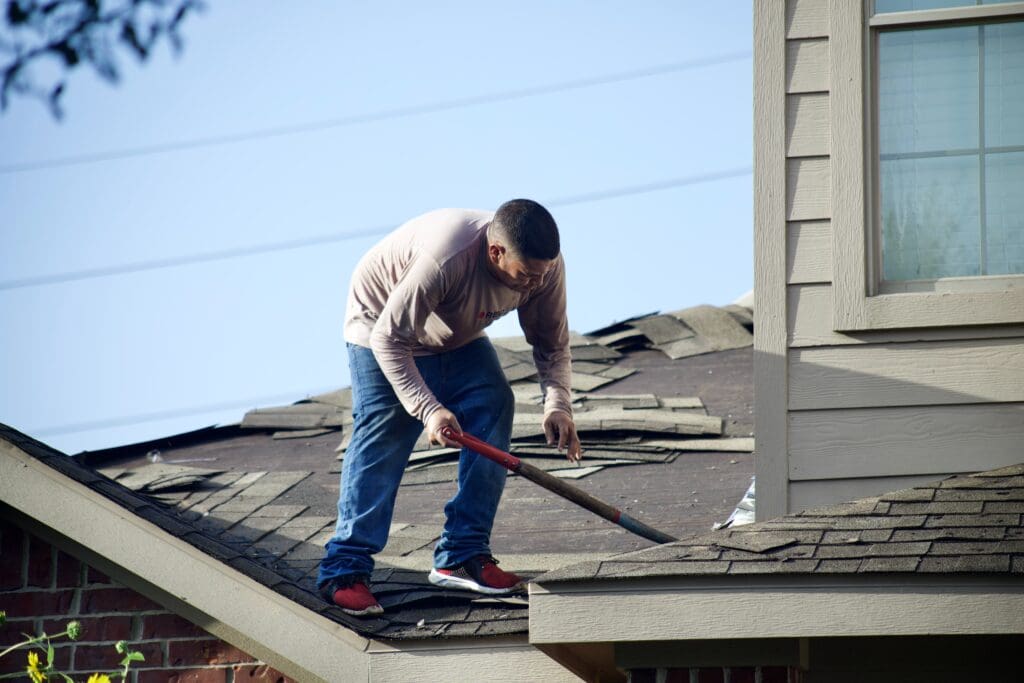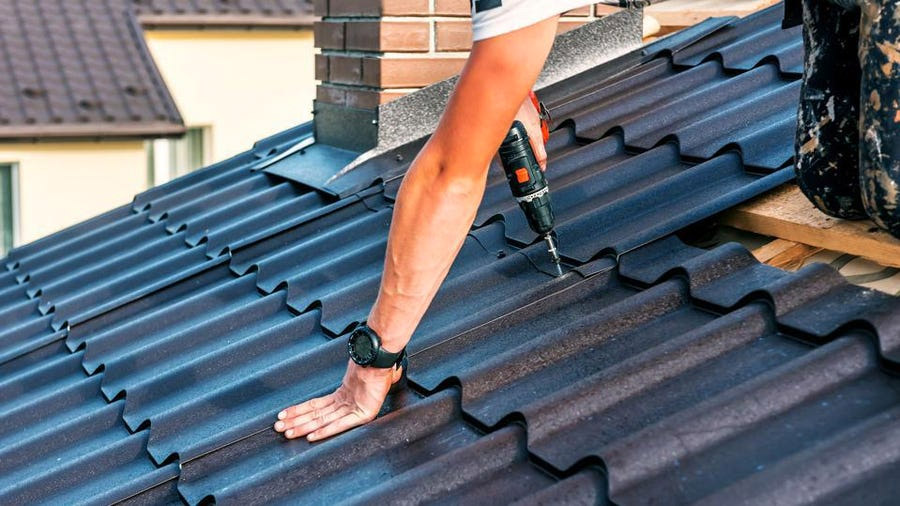
Introduction
Your roof is one of the most important components of your home, providing protection from the elements and helping to maintain energy efficiency. Over time, wear and tear can lead to issues that require attention, but how do you know whether to opt for roof repair or replace? This decision depends on several factors, including the signs of roof damage, the cost of roof replacement, and the longevity of your existing materials. Postponing an entire roof replacement in favor of temporary repairs can lead to greater long-term expenses and damage. In this guide, we’ll help you determine the best course of action for your roof and explore the best roofing materials for long-term durability.
Making the right decision about your roof involves balancing cost, longevity, and functionality. Homeowners often struggle with whether to make temporary repairs or invest in a full replacement. Roof replacement cost is a crucial factor in this decision-making process, as the initial costs can be significant but may prevent higher cumulative expenses from ongoing repairs. By understanding the pros and cons of each approach, you can make an informed decision that best suits your home’s needs and budget.
Common Roof Damage Indicators Every Madison Homeowner Should Know
Understanding the signs of roof damage is the first step in deciding whether a repair or full replacement is necessary. Some issues can be resolved with simple repairs, while others indicate that your roof has reached the end of its lifespan. Here are some key warning signs to look for:
- Missing or damaged shingles: If only a few shingles are missing or damaged, a repair might be sufficient. However, widespread damage suggests the need for replacement.
- Leaks and water damage: Water stains on ceilings, mold growth, or sagging areas can indicate underlying structural issues.
- Leaky roof: A leaky roof is a common issue that can lead to necessary repairs or replacements. Promptly addressing a leaky roof is crucial to prevent escalation into more severe problems, such as water damage and structural issues within the home.
- Granule loss: If you notice excessive granules in your gutters, it may mean your shingles are deteriorating and losing their protective coating.
- Protective layer: The granules on shingles serve as a protective layer, shielding them from UV damage and other elements. A new layer of shingles can also act as a protective layer when re-roofing, offering a fresh appearance while considering potential drawbacks.
- Age of the roof: Most asphalt shingle roofs last 20–30 years. If your roof is nearing this age, replacement may be the best option.
- Moss and mold growth: Moisture retention can cause moss and mold buildup, which may indicate trapped water and deeper damage.
Many homeowners don’t notice roof problems until significant damage has already occurred. This is why routine roof inspections are essential. A professional assessment can help detect hidden issues early, preventing expensive repairs or even structural damage in the future.
Top Causes of Roof Damage and How to Stop Them
Roof damage can stem from a variety of sources, each contributing to the wear and tear of your roofing materials. Weather conditions are a primary culprit; heavy rain, hail, and strong winds can all inflict significant damage, leading to leaks and other issues. Over time, the natural aging process also takes its toll, causing materials to deteriorate, crack, and break. Neglecting regular maintenance further exacerbates these problems, allowing minor issues to escalate into major damage.
Tree branches and leaves are another common cause of roof damage. Branches that rub against the roof can wear down shingles and other roofing materials, while leaves can clog gutters and downspouts, leading to water damage. Animals such as squirrels, raccoons, and birds can also be problematic, especially if they attempt to nest or search for food within your roof structure.
Poor installation is a less obvious but equally significant factor. A roof that isn’t installed correctly can suffer from a range of issues, including leaks and structural damage. Finally, a lack of maintenance, such as failing to clean gutters or inspect for damage, can lead to severe roof damage over time. Regular inspections and timely repairs are essential to maintaining the integrity of your roof and preventing costly problems down the line.
How to Evaluate Your Roof’s Condition Before Repair or Replacement
Evaluating the condition of your roof is a crucial step in deciding whether to opt for repair or replacement. Start by considering the age of your roof. Most roofs, especially those made from asphalt shingles, have a lifespan of 20-30 years. If your roof is approaching this age, it may be time to consider a replacement.
Next, inspect the condition of your shingles. Look for signs of damage such as cracks, breaks, or missing shingles, which can indicate roof damage. The state of your flashing is also important; this material surrounds chimneys, vents, and skylights, and if it’s damaged or missing, it can lead to leaks.
Don’t forget to check your gutters and downspouts. Clogged gutters can cause water to back up and damage your roof. Finally, look for signs of leaks inside your home, such as water stains, warping, or discoloration on ceilings and walls. These indicators can help you assess the overall health of your roof and determine the best course of action.
How to Decide When Roof Repair Is the Best Option
If your roof is still relatively young and the damage is localized, roof repair can be a cost-effective and practical solution. Minor leaks, a small number of missing shingles, or flashing issues can often be resolved without replacing the entire roof. Choosing repair over replacement can save money while still extending the life of your roof. However, it’s important to address issues promptly to prevent minor problems from escalating into costly damage. Finding matching shingles is essential for a cohesive and aesthetically pleasing repair, as mismatched shingles can detract from the overall appearance if repairs are made rather than opting for complete replacements.
Roof repairs are particularly beneficial when only a small section of the roof is affected. Whether it’s storm damage or a minor leak, addressing these issues early can help maintain the integrity of your roof. Additionally, if your roof is still under warranty, repairs may be covered, reducing your out-of-pocket expenses.
When Roof Replacement Is the Right Choice for Your Home
In some cases, roof replacement is the more practical and cost-effective long-term solution. If your roof has widespread damage, is near the end of its lifespan, or has recurring issues despite previous repairs, a full replacement may be the better investment. While the cost of roof replacement can be higher upfront, it provides peace of mind and ensures your home is fully protected. Additionally, replacing an old or damaged roof can improve energy efficiency and increase property value. Proper attic ventilation is crucial during roof replacement, and addressing common issues with roof vents can prevent bigger problems down the line.
A new roof not only enhances protection but also improves the overall aesthetic appeal of your home. Modern roofing materials offer improved durability, better insulation, and more stylish design options, making a replacement a worthwhile investment. If you’re planning to sell your home in the near future, a new roof can be a strong selling point that boosts curb appeal and resale value.
How Much Does a Roof Replacement Cost in Madison, WI?

The cost of roof replacement varies based on factors such as roof size, materials used, and labor costs. On average, homeowners can expect to pay between $5,000 and $15,000 for a new roof, though premium materials and complex installations may cost more. The average pricing of various roofing materials and services is often measured per square foot, providing a standard estimate for expenses. While this is a significant investment, many homeowners find that a new roof reduces energy bills, enhances curb appeal, and prevents costly structural damage in the future.
Additional factors such as roof pitch, accessibility, and removal of old roofing materials can also impact costs. It’s important to get multiple quotes from reputable contractors to ensure you receive the best value. Homeowners should also consider financing options, as some roofing companies offer payment plans or work with lenders to provide affordable solutions.
Factors Affecting Cost
The cost of a new roof can vary widely based on several factors. One of the most significant is the size of your roof; larger roofs require more materials and labor, increasing the overall cost. The type of roofing material you choose also plays a crucial role. Asphalt shingles are generally the most affordable option, while materials like slate and metal can be more expensive.
The complexity of the job is another important consideration. Roofs with multiple valleys, skylights, and chimneys require more intricate work, which can drive up costs. Your location also matters; roofs in areas with high winds, heavy rainfall, or extreme temperatures may need more durable and expensive materials.
Labor costs can vary depending on your location and the contractor you choose. It’s essential to get multiple quotes to ensure you’re getting the best value for your investment. By understanding these factors, you can better plan for the financial aspects of your roof replacement.
Long-Term Considerations
When contemplating a new roof, it’s essential to think beyond the immediate costs and consider long-term factors. Durability is a key consideration; you want a roof that will last for many years without requiring frequent repairs. Different roofing materials offer varying levels of durability, so choose one that fits your long-term needs.
Maintenance is another important factor. Some roofing materials, like wood shingles, require more upkeep than others. Consider how much time and effort you’re willing to invest in maintaining your roof. Energy efficiency is also crucial; a well-insulated roof can help reduce energy costs by keeping your home cooler in the summer and warmer in the winter.
Resale value is another consideration. A new roof can significantly increase the resale value of your home, making it a worthwhile investment if you plan to sell in the future. Finally, look at the warranty offered by the manufacturer. A good warranty can provide peace of mind and protect your investment for years to come.
Building Codes and Regulations
Adhering to building codes and regulations is essential when replacing your roof. Local building codes can vary, so it’s important to check with local authorities to understand the specific requirements in your area. This may include obtaining necessary permits before starting the work.
Inspections are often required to ensure that the roof is installed correctly and complies with all local regulations. Failing to adhere to these codes can result in fines and may even require you to redo the work. Ensuring compliance with all local building codes and regulations not only protects you legally but also ensures that your new roof is safe and durable.
By considering these factors and following local regulations, you can ensure a smooth and successful roof replacement process.
How to Choose the Right Roofing Material for Your Home
Selecting the best roofing materials is crucial for maximizing durability and performance. Here are some of the most popular options:
- Asphalt shingles: Affordable, easy to install, and available in various styles, asphalt shingles are the most common roofing material.
- Metal roofing: Known for its durability and energy efficiency, metal roofing can last 40–70 years with minimal maintenance.
- Wood shingles and shakes: These offer a natural, rustic look but require regular maintenance to prevent rot and insect damage.
- Slate roofing: One of the longest-lasting options, slate is incredibly durable but also one of the most expensive materials.
- Clay or concrete tiles: Often used in warmer climates, these materials provide excellent durability and insulation but require a strong roof structure due to their weight.
When choosing a roofing material, consider factors such as climate, maintenance requirements, and overall aesthetics. Each material has its strengths and weaknesses, so consulting with a roofing professional can help you select the best option for your home’s long-term protection and performance.
Conclusion
Deciding between roof repair or replacement depends on the extent of the damage, the age of your roof, and your long-term goals. While repairs can address minor issues and extend your roof’s lifespan, a full replacement is often the better option for ageing or severely damaged roofs. Considering the cost of roof replacement and the best roofing materials can help you make an informed decision.
If you’re uncertain about the best course of action, a professional roofing inspection can provide clarity. Investing in a well-maintained, durable roof is essential for safeguarding your home and ensuring long-term comfort. Whether you opt for repair or replacement, prioritizing quality materials and expert installation will yield the best results.
Get Professional Roofing Services from Exterior Renovations
At Exterior Renovations, we specialize in roof inspections, repairs, and full replacements. Our experienced team can assess your roof’s condition and recommend the best solution for your home. Contact us today to schedule a consultation and ensure your roof is in top shape for years to come.
